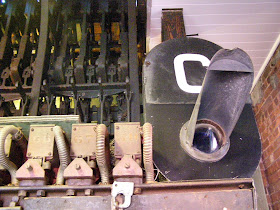In fact, I had heard that the LIRR had been using the "Flashing Green" aspect to indicate Absolute Block Clear. It had never seen it, but it made sense. Not to mention they had Manual Block Clear as an existing option as well. A quick google search actually found a previously unknown LIRR signal rule reference.
NAME: Absolute-Clear.Yeah, there you go. If you want to go to color light, just use *G*/R. A nice uniform difference from NORAC Cab Speed.
INDICATION: Proceed; Track clear to next interlocking signal. Approach next interlocking signal prepared to stop.
Huh? *G*/*R*? That's a bit...odd. I guess they really want to make it different from anything that might appear in the Amtrak zone? Wait a minute...what's that in the text of Rule 298B?
Absolute Medium Clear? Absolute Slow Clear? Oh no..
NAME: Absolute-Medium-clear.
INDICATION: Proceed; Medium Speed within interlocking limits. Track clear to next interlocking signal. Approach next interlocking signal prepared to stop.
Are you kidding me? This is the sort of think a child would come up with for their imagination railroad. Oh wait, it gets crazier.
NAME: Absolute Slow-clear.
INDICATION: Proceed; Slow speed within interlocking limits. Track clear to next interlocking signal. Approach next interlocking signal prepared to stop.
Yup, that is a flashing three headed signal. I mean I guess I see the logic. The LIRR doesn't use flashing signals outside of the Amtrak zone so this associates flashing with an absolute block while not duplicating any existing signal aspects.
NAME: Slow-approach
INDICATION: Proceed approaching next signal prepared to stop. Slow speed within interlocking limits
Ok, I guess that brakes the pattern. Wait, on the PRR Slow Approach can stand in for Slow Clear on high signals. What does the LIRR do there?
NAME: Flashing Slow-approach.
INDICATION: Train will proceed in accordance with signal indication within interlocking limits and after clearing the interlocking, proceed under absolute clear indication to the next interlocking.
They named a signal indication "Flashing Slow Approach". I guess the other three signal rules used up all their creativity juice. The fact that I only became aware of all this now just shows the extent to which the LIRR keeps its operating practices under wraps. To be fair, this isn't as crazy as it appears. Like I said, when this was developed in the 1970's the LIRR had avoided flashing signal aspects and also wanted to avoid conflicts with Amtrak zone signals (although there was and is no wayside-free operation in the Amtrak zone). In the relay hut logic could use a single flashing circuit applied to the entire output of a signal when an Absolute Block signal was called for AND the system avoids the odd case of a "Clear to Next Interlocking" displayed along side an Approach signal, which can happen under NORAC despite being redundant.
 |
| This here is how you do absolute block. End of discussion. |
 |
| Metro-North started fresh in 1983 and first choose the PRR solution. |

















I don't see how flashing aspects is an overtime conspiracy. The fact of the matter is while 4 rules and 13 aspects were added but they're all logical extension of already existing aspects so it's hardly Byzantine. All the signals in the rule book follow the simple progression that has been around for generations. Meanwhile the NORAC color light low homes require a but of time to pick up since they don't quite fit with the signal pattern that otherwise exists.
ReplyDeleteThe Flashing Slow Approach only exists to avoid having to modify signals in the field, so it was either have a signal with a funny name or buy new signals.
The fact of the matter is doing it that way required no procurement and laid over the existing system.
Having experienced/observed both I prefer the flahsing Absolutes, theyre much easier to distinguish when the line is populated with lights a flashing white light will not immediately stand out. In the rural woods Im sure its fine but in dense urban areas its nice to know that its definitively a signal with no effort rather than having to spend a second or two thinking about it.
As far as manual block I don't think it's on management's radar since it works just fine. MNCR still has FORM M Block Limit signals and Amtrak still has FORM D DCS, no one seems in a hurry to pull them out.
The only thing that factors into it is costs and there isnt a justification to add signals that rarely get used. The money hungry signal employees would love more gadgets to generate work.
But head office decides where to allocate resources, and oddly enough, they write the operating rules and procedures with minimal input from front line employees.